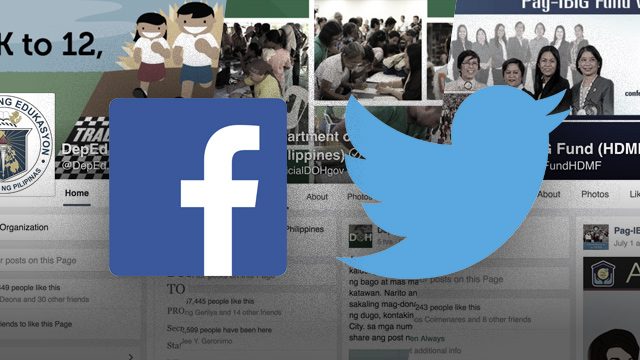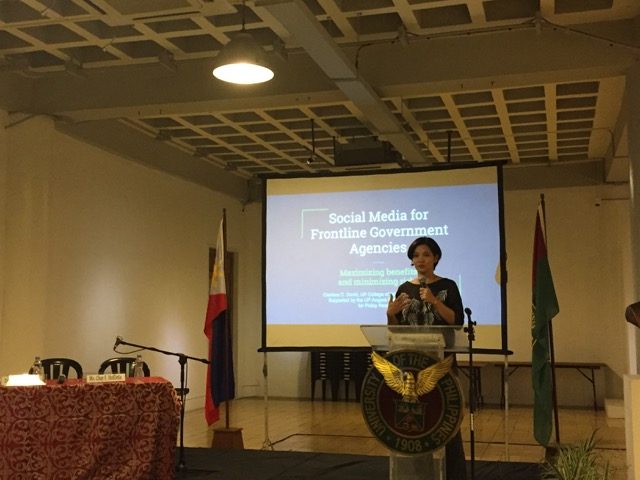SUMMARY
This is AI generated summarization, which may have errors. For context, always refer to the full article.

MANILA, Philippines – In this digital age, anything and everyone has a social media page – celebrities, journalists, philosophies, topics, products and even government agencies.
With over 50 million Filipinos logged on to Facebook almost 24 hours, social media is an audience public offices cannot ignore. Almost all public offices – from the President down to some barangays – have a presence on social media. But not all have been successful in keeping up with the ever-evolving platform, especially in terms of user engagement. (READ: A Profile of Internet Users in the Philippines)
Research by University of the Philippines (UP) Communication Research Professor Clarissa David shows that the Facebook page of the Office of the President has over 4.2 million followers while its Twitter counterpart has 3.1 million. Meanwhile, the Office of the Vice President has 2.7 million and 334,000 followers on Facebook and Twitter, respectively.
But most of the other government agencies have a low number of followers despite the importance of their functions. These include the Departments of Social Welfare and Development (DSWD), Budget and Management (DBM), Presidential Communications Office (PCO), and the National Economic Development Authority (NEDA), among others.
Others, however – like the Department of Health (DOH) with a huge following at over 550,000, have a low user engagement because of the nature of the posts shared on their timeline. These are mostly press releases and reposted news items about the agency.
“They do social media without even thinking [about] communication strategies or what the needs of their audience are,” said UP Journalism professor Rachel Khan, a reactor to David’s presentation.
In her presentation of research findings Tuesday, July 5, to academics and communication officers of government agencies, David talked about strategies that government offices can use in mounting and managing their social media accounts.

The do’s and don’t’s
Titled “Social Media Policy for Frontline Government Agencies”, the study monitored the posts and engagements of 3 line public offices that have a high social media following: DOH, Department of Education (DepEd) and Home Development Mutual Fund (HDMF, popularly called Pag-ibig Fund).
Among the laudable practices found in the social media posts of these agencies were:
- Responsiveness to queries – DepEd and Pag-ibig reply with specific answers to questions their clientele post on the comments box.
- Website integration – Responses come with hyperlinks of the specific section or document found in the official website that directly addresses the users’ concern. David noted that integrating website content with social media accounts is crucial in creating a habit among users that urges them to check the official websites since information on social media does not appear forever on their timeline.
- Setting a voice – Comments usually start with a “Hi, (name)!” that denotes an air of informality and less stiffness on the part of the agency.
- Crowdsourcing
Meanwhile, those that need to be avoided are:
- Posting photos with officials – DOH has the highest number of posts with their agency heads. David said that the audience can see through this post as just a form of publicity or public relations, which lowers the credibility of the agency.
- Infographics – Content on Pag-ibig’s Facebook page is heavy on this. Although it is very informative, a blurb must be included in the post since text in images is not searchable.
- Human interest angles – The study found that these types of content do not gain as much engagement. But Rappler editor Chay Hofileña, who was also a reactor, disagreed and said that for the media, what matters is good writing and human interest stories. She said these stories can be picked up or pursued by the media with a more in-depth take or approach.
- Outsourcing: DOH’s social media handler is an outsourced third party service provider. David said that the team should be in house for “effective content generation and referral system.” DepEd’s social media team, for example, reports directly to the Office of the Secretary.
“For social media to be powerful and effective, it should be fully integrated in the overall communication digital strategy of the agency or the company,” David said.
Benefits, risks
The government’s presence on social media platforms benefits both the office and citizens. This saves both the public and government offices resources that would have otherwise been used to address concerns since social media is free, fast, and easily accessible.
“[Social media] serves as the megaphone of government agencies and the sumbungan (complaint center) of citizens,” said David.
“This is very important in reputation management and reputation-building, and providing services for online queries among citizens,” she stressed.
David also said that social media provides a platform for government agencies to directly communicate with their constituency without having to go through the filters of media. This gives them more control over their messaging.
But public offices must be wary of the risks that come with setting up their digital presence. These include exercising too much control over posts by having several layers of approval before release. Another one is the quick virality of a bad post that could turn into a huge image problem. David cited a past DOH social media campaign on teen pregnancy.
These perils, David said, can be managed better by having dedicated personnel who should be given autonomy in crafting posts for social media platforms. Providing guidelines on general language and decorum online will also boost institutionalizing good practices. – Rappler.com
Add a comment
How does this make you feel?
There are no comments yet. Add your comment to start the conversation.